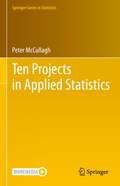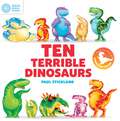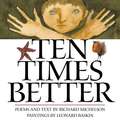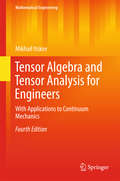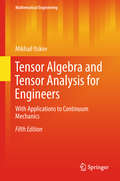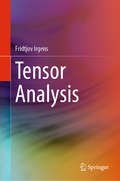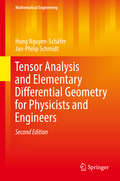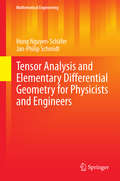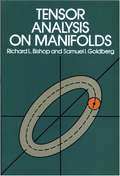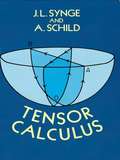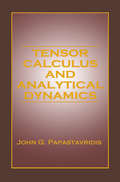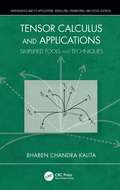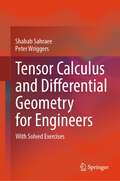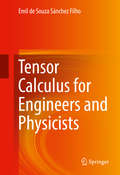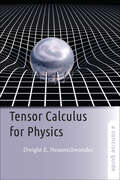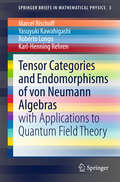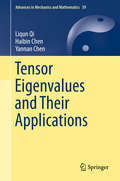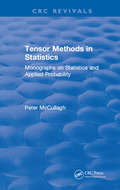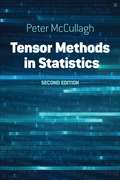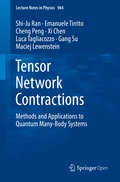- Table View
- List View
Ten Projects in Applied Statistics (Springer Series in Statistics)
by Peter McCullaghThe first half of the book is aimed at quantitative research workers in biology, medicine, ecology and genetics. The book as a whole is aimed at graduate students in statistics, biostatistics, and other quantitative disciplines. Ten detailed examples show how the author approaches real-world statistical problems in a principled way that allows for adequate compromise and flexibility. The need to accommodate correlations associated with space, time and other relationships is a recurring theme, so variance-components models feature prominently. Statistical pitfalls are illustrated via examples taken from the recent scientific literature. Chapter 11 sets the scene, not just for the second half of the book, but for the book as a whole. It begins by defining fundamental concepts such as baseline, observational unit, experimental unit, covariates and relationships, randomization, treatment assignment, and the role that these play in model formulation. Compatibility of the model with the randomization scheme is crucial. The effect of treatment is invariably modelled as a group action on probability distributions. Technical matters connected with space-time covariance functions, residual likelihood, likelihood ratios, and transformations are discussed in later chapters.
Ten Sly Piranhas: A Counting Story In Reverse (a Tale Of Wickedness - And Worse!)
by William WiseA school of ten sly piranhas gradually dwindles as they waylay and eat each other.
Ten Terrible Dinosaurs
by Paul SticklandThis lively counting book stars the same colourful dinosaurs as in the classic picture book Dinosaur Roar! The bouncy rhyming text encourages children to join in, helping them to learn their numbers as they count down from ten to one, ending with a wonderful loud ROAR!Ten terrible dinosaurs standing in a line, soon began to mess about until there were . . . NINE.
Ten Times Better
by Richard Michelson Leonard BaskinRichard Michelson and the late Leonard Baskin show that learning to count and to multiply by ten need never be boring! In a counting book like no other, a variety of animals duel for the honor of the number they represent. Backed up by interesting natural history information, the poems are clever, sometimes even preposterous. Bold watercolors convey the animals' conviction that their number is undoubtedly the best! Children will laugh their way along the road to numerical literacy.
Ten, Nine, Eight
by Molly BangNine stuffed animals, one sleepy toddler. Numbers from ten to one are part of this lullaby which observes the room of a little girl going to bed.<P><P> Winner of the Caldecott Honor
Tennessee Senior Bridge Mathematics
by Randall I. Charles The Consortium for Foundation Mathematics Robert BlitzerNIMAC-sourced textbook
Tensor Algebra and Tensor Analysis for Engineers
by Mikhail ItskovThere is a large gap between the engineering course in tensor algebra on the one hand and the treatment of linear transformations within classical linear algebra on the other hand. The aim of this modern textbook is to bridge this gap by means of the consequent and fundamental exposition. The book primarily addresses engineering students with some initial knowledge of matrix algebra. Thereby the mathematical formalism is applied as far as it is absolutely necessary. Numerous exercises are provided in the book and are accompanied by solutions, enabling self-study. The last chapters of the book deal with modern developments in the theory of isotropic and anisotropic tensor functions and their applications to continuum mechanics and are therefore of high interest for PhD-students and scientists working in this area. This third edition is completed by a number of additional figures, examples and exercises. The text and formulae have been revised and improved where necessary.
Tensor Algebra and Tensor Analysis for Engineers: With Applications To Continuum Mechanics (Mathematical Engineering Ser.)
by Mikhail ItskovThis is the fifth and revised edition of a well-received textbook that aims at bridging the gap between the engineering course of tensor algebra on the one hand and the mathematical course of classical linear algebra on the other hand. In accordance with the contemporary way of scientific publication, a modern absolute tensor notation is preferred throughout. The book provides a comprehensible exposition of the fundamental mathematical concepts of tensor calculus and enriches the presented material with many illustrative examples. As such, this new edition also discusses such modern topics of solid mechanics as electro- and magnetoelasticity. In addition, the book also includes advanced chapters dealing with recent developments in the theory of isotropic and anisotropic tensor functions and their applications to continuum mechanics. Hence, this textbook addresses graduate students as well as scientists working in this field and in particular dealing with multi-physical problems. In each chapter numerous exercises are included, allowing for self-study and intense practice. Solutions to the exercises are also provided.
Tensor Analysis
by Fridtjov IrgensThis book presents tensors and tensor analysis as primary mathematical tools for engineering and engineering science students and researchers. The discussion is based on the concepts of vectors and vector analysis in three-dimensional Euclidean space, and although it takes the subject matter to an advanced level, the book starts with elementary geometrical vector algebra so that it is suitable as a first introduction to tensors and tensor analysis. Each chapter includes a number of problems for readers to solve, and solutions are provided in an Appendix at the end of the text. Chapter 1 introduces the necessary mathematical foundations for the chapters that follow, while Chapter 2 presents the equations of motions for bodies of continuous material. Chapter 3 offers a general definition of tensors and tensor fields in three-dimensional Euclidean space. Chapter 4 discusses a new family of tensors related to the deformation of continuous material. Chapter 5 then addresses constitutive equations for elastic materials and viscous fluids, which are presented as tensor equations relating the tensor concept of stress to the tensors describing deformation, rate of deformation and rotation. Chapter 6 investigates general coordinate systems in three-dimensional Euclidean space and Chapter 7 shows how the tensor equations discussed in chapters 4 and 5 are presented in general coordinates. Chapter 8 describes surface geometry in three-dimensional Euclidean space, Chapter 9 includes the most common integral theorems in two- and three-dimensional Euclidean space applied in continuum mechanics and mathematical physics.
Tensor Analysis and Elementary Differential Geometry for Physicists and Engineers (Mathematical Engineering #21)
by Hung Nguyen-Schäfer Jan-Philip SchmidtThis book presents tensors and differential geometry in a comprehensive and approachable manner, providing a bridge from the place where physics and engineering mathematics end, and the place where tensor analysis begins. Among the topics examined are tensor analysis, elementary differential geometry of moving surfaces, and k-differential forms. The book includes numerous examples with solutions and concrete calculations, which guide readers through these complex topics step by step. Mindful of the practical needs of engineers and physicists, book favors simplicity over a more rigorous, formal approach. The book shows readers how to work with tensors and differential geometry and how to apply them to modeling the physical and engineering world.The authors provide chapter-length treatment of topics at the intersection of advanced mathematics, and physics and engineering: • General Basis and Bra-Ket Notation• Tensor Analysis• Elementary Differential Geometry• Differential Forms• Applications of Tensors and Differential Geometry• Tensors and Bra-Ket Notation in Quantum MechanicsThe text reviews methods and applications in computational fluid dynamics; continuum mechanics; electrodynamics in special relativity; cosmology in the Minkowski four-dimensional space time; and relativistic and non-relativistic quantum mechanics.Tensor Analysis and Elementary Differential Geometry for Physicists and Engineers benefits research scientists and practicing engineers in a variety of fields, who use tensor analysis and differential geometry in the context of applied physics, and electrical and mechanical engineering. It will also interest graduate students in applied physics and engineering.
Tensor Analysis and Elementary Differential Geometry for Physicists and Engineers (Mathematical Engineering)
by Hung Nguyen-Schäfer Jan-Philip SchmidtTensors and methods of differential geometry are very useful mathematical tools in many fields of modern physics and computational engineering including relativity physics, electrodynamics, computational fluid dynamics (CFD), continuum mechanics, aero and vibroacoustics and cybernetics.This book comprehensively presents topics, such as bra-ket notation, tensor analysis and elementary differential geometry of a moving surface. Moreover, authors intentionally abstain from giving mathematically rigorous definitions and derivations that are however dealt with as precisely as possible. The reader is provided with hands-on calculations and worked-out examples at which he will learn how to handle the bra-ket notation, tensors and differential geometry and to use them in the physical and engineering world. The target audience primarily comprises graduate students in physics and engineering, research scientists and practicing engineers.
Tensor Analysis on Manifolds
by Samuel I. Goldberg Richard L. Bishop"This is a first-rate book and deserves to be widely read." -- American Mathematical MonthlyDespite its success as a mathematical tool in the general theory of relativity and its adaptability to a wide range of mathematical and physical problems, tensor analysis has always had a rather restricted level of use, with an emphasis on notation and the manipulation of indices. This book is an attempt to broaden this point of view at the stage where the student first encounters the subject. The authors have treated tensor analysis as a continuation of advanced calculus, striking just the right balance between the formal and abstract approaches to the subject.The material proceeds from the general to the special. An introductory chapter establishes notation and explains various topics in set theory and topology. Chapters 1 and 2 develop tensor analysis in its function-theoretical and algebraic aspects, respectively. The next two chapters take up vector analysis on manifolds and integration theory. In the last two chapters (5 and 6) several important special structures are studied, those in Chapter 6 illustrating how the previous material can be adapted to clarify the ideas of classical mechanics. The text as a whole offers numerous examples and problems.A student with a background of advanced calculus and elementary differential equation could readily undertake the study of this book. The more mature the reader is in terms of other mathematical knowledge and experience, the more he will learn from this presentation.
Tensor Calculus
by J. L. Synge A. Schild"This book is an excellent classroom text, since it is clearly written, contains numerous problems and exercises, and at the end of each chapter has a summary of the significant results of the chapter." -- Quarterly of Applied Mathematics. Fundamental introduction for beginning student of absolute differential calculus and for those interested in applications of tensor calculus to mathematical physics and engineering. Topics include spaces and tensors; basic operations in Riemannian space, curvature of space, special types of space, relative tensors, ideas of volume, and more.
Tensor Calculus and Analytical Dynamics (Engineering Mathematics Ser. #4)
by John G. PapastavridisTensor Calculus and Analytical Dynamics provides a concise, comprehensive, and readable introduction to classical tensor calculus - in both holonomic and nonholonomic coordinates - as well as to its principal applications to the Lagrangean dynamics of discrete systems under positional or velocity constraints. The thrust of the book focuses on formal structure and basic geometrical/physical ideas underlying most general equations of motion of mechanical systems under linear velocity constraints.Written for the theoretically minded engineer, Tensor Calculus and Analytical Dynamics contains uniquely accessbile treatments of such intricate topics as: tensor calculus in nonholonomic variables Pfaffian nonholonomic constraints related integrability theory of FrobeniusThe book enables readers to move quickly and confidently in any particular geometry-based area of theoretical or applied mechanics in either classical or modern form.
Tensor Calculus and Applications: Simplified Tools and Techniques (Mathematics and its Applications)
by Bhaben KalitaThe aim of this book is to make the subject easier to understand. This book provides clear concepts, tools, and techniques to master the subject -tensor, and can be used in many fields of research. Special applications are discussed in the book, to remove any confusion, and for absolute understanding of the subject. In most books, they emphasize only the theoretical development, but not the methods of presentation, to develop concepts. Without knowing how to change the dummy indices, or the real indices, the concept cannot be understood. This book takes it down a notch and simplifies the topic for easy comprehension. Features Provides a clear indication and understanding of the subject on how to change indices Describes the original evolution of symbols necessary for tensors Offers a pictorial representation of referential systems required for different kinds of tensors for physical problems Presents the correlation between critical concepts Covers general operations and concepts
Tensor Calculus and Differential Geometry for Engineers: With Solved Exercises
by Peter Wriggers Shahab SahraeeThe book contains the basics of tensor algebra as well as a comprehensive description of tensor calculus, both in Cartesian and curvilinear coordinates. Some recent developments in representation theorems and differential forms are included. The last part of the book presents a detailed introduction to differential geometry of surfaces and curves which is based on tensor calculus. By solving numerous exercises, the reader is equipped to properly understand the theoretical background and derivations. Many solved problems are provided at the end of each chapter for in-depth learning. All derivations in this text are carried out line by line which will help the reader to understand the basic ideas. Each figure in the book includes descriptive text that corresponds with the theoretical derivations to facilitate rapid learning.
Tensor Calculus for Engineers and Physicists
by Emil de Souza Sánchez FilhoThistextbook provides a rigorous approach to tensor manifolds in several aspects relevantfor Engineers and Physicists working in industry or academia. With a thorough,comprehensive, and unified presentation, this book offers insights into severaltopics of tensor analysis, which covers all aspects of N dimensional spaces. The mainpurpose of this book is to give a self-contained yet simple, correct andcomprehensive mathematical explanation of tensor calculus for undergraduate andgraduate students and for professionals. In addition to many worked problems,this book features a selection of examples, solved step by step. Although noemphasis is placed on special and particular problems of Engineering orPhysics, the text covers the fundamentals of these fields of science. The bookmakes a brief introduction into the basic concept of the tensorial formalism soas to allow the reader to make a quick and easy review of the essential topicsthat enable having the grounds for the subsequent themes, without needing toresort to other bibliographical sources on tensors. Chapter 1 deals withFundamental Concepts about tensors and chapter 2 is devoted to the study ofcovariant, absolute and contravariant derivatives. The chapters 3 and 4 arededicated to the Integral Theorems and Differential Operators, respectively. Chapter 5 deals with Riemann Spaces, and finally the chapter 6 presents aconcise study of the Parallelism of Vectors. It also shows how to solve variousproblems of several particular manifolds.
Tensor Calculus for Physics: A Concise Guide
by Dwight E. NeuenschwanderUsing a clear, step-by-step approach, this book explains one of the more difficult—yet crucial—topics in physics.Understanding tensors is essential for any physics student dealing with phenomena where causes and effects have different directions. A horizontal electric field producing vertical polarization in dielectrics; an unbalanced car wheel wobbling in the vertical plane while spinning about a horizontal axis; an electrostatic field on Earth observed to be a magnetic field by orbiting astronauts—these are some situations where physicists employ tensors. But the true beauty of tensors lies in this fact: When coordinates are transformed from one system to another, tensors change according to the same rules as the coordinates. Tensors, therefore, allow for the convenience of coordinates while also transcending them. This makes tensors the gold standard for expressing physical relationships in physics and geometry. Undergraduate physics majors are typically introduced to tensors in special-case applications. For example, in a classical mechanics course, they meet the "inertia tensor," and in electricity and magnetism, they encounter the "polarization tensor." However, this piecemeal approach can set students up for misconceptions when they have to learn about tensors in more advanced physics and mathematics studies (e.g., while enrolled in a graduate-level general relativity course or when studying non-Euclidean geometries in a higher mathematics class). Dwight E. Neuenschwander's Tensor Calculus for Physics is a bottom-up approach that emphasizes motivations before providing definitions. Using a clear, step-by-step approach, the book strives to embed the logic of tensors in contexts that demonstrate why that logic is worth pursuing. It is an ideal companion for courses such as mathematical methods of physics, classical mechanics, electricity and magnetism, and relativity.
Tensor Categories and Endomorphisms of von Neumann Algebras
by Marcel Bischoff Yasuyuki Kawahigashi Roberto Longo Karl-Henning RehrenC* tensor categories are a point of contact where Operator Algebras and Quantum Field Theory meet. They are the underlying unifying concept for homomorphisms of (properly infinite) von Neumann algebras and representations of quantum observables. The present introductory text reviews the basic notions and their cross-relations in different contexts. The focus is on Q-systems that serve as complete invariants, both for subfactors and for extensions of quantum field theory models. It proceeds with various operations on Q-systems (several decompositions, the mirror Q-system, braided product, centre and full centre of Q-systems) some of which are defined only in the presence of a braiding. The last chapter gives a brief exposition of the relevance of the mathematical structures presented in the main body for applications in Quantum Field Theory (in particular two-dimensional Conformal Field Theory, also with boundaries or defects).
Tensor Eigenvalues and Their Applications (Advances in Mechanics and Mathematics #39)
by Liqun Qi Haibin Chen Yannan ChenThis book offers an introduction to applications prompted by tensor analysis, especially by the spectral tensor theory developed in recent years. It covers applications of tensor eigenvalues in multilinear systems, exponential data fitting, tensor complementarity problems, and tensor eigenvalue complementarity problems. It also addresses higher-order diffusion tensor imaging, third-order symmetric and traceless tensors in liquid crystals, piezoelectric tensors, strong ellipticity for elasticity tensors, and higher-order tensors in quantum physics. This book is a valuable reference resource for researchers and graduate students who are interested in applications of tensor eigenvalues.
Tensor Methods in Statistics: Monographs on Statistics and Applied Probability
by P. McCullaghThis book provides a systematic development of tensor methods in statistics, beginning with the study of multivariate moments and cumulants. The effect on moment arrays and on cumulant arrays of making linear or affine transformations of the variables is studied. Because of their importance in statistical theory, invariant functions of the cumulants are studied in some detail. This is followed by an examination of the effect of making a polynomial transformation of the original variables. The fundamental operation of summing over complementary set partitions is introduced at this stage. This operation shapes the notation and pervades much of the remainder of the book. The necessary lattice-theory is discussed and suitable tables of complementary set partitions are provided. Subsequent chapters deal with asymptotic approximations based on Edgeworth expansion and saddlepoint expansion. The saddlepoint expansion is introduced via the Legendre transformation of the cumulant generating function, also known as the conjugate function of the cumulant generating function. A recurring them is that, with suitably chosen notation, multivariate calculations are often simpler and more transparent than the corresponding univariate calculations. The final two chapters deal with likelihood ratio statistics, maximum likelihood estimation and the effect on inferences of conditioning on ancillary or approximately ancillary statistics. The Bartlett adjustment factor is derived in the general case and simplified for certain types of generalized linear models. Finally, Barndorff-Nielsen's formula for the conditional distribution of the maximum liklelihood estimator is derived and discussed. More than 200 Exercises are provided to illustrate the uses of tensor methodology.
Tensor Methods in Statistics: Second Edition
by Peter McCullaghA pioneering monograph on tensor methods applied to distributional problems arising in statistics, this work constitutes a valuable reference for graduate students and professional statisticians. Prerequisites include some knowledge of linear algebra, eigenvalue decompositions, and linear models as well as likelihood functions and likelihood ratio statistics. Index notation is the favored mode of expression throughout the book. The first chapter introduces a number of aspects of index notation, groups, invariants, and tensor calculus, with examples drawn from linear algebra, physics, and statistics. Subsequent chapters form the core of the text, addressing moments, cumulants, and invariants. Additional topics include sample cumulants, Edgeworth series, saddlepoint approximation, likelihood functions, and ancillary statistics. More than 200 exercises form an integral part of the text.
Tensor Network Contractions: Methods and Applications to Quantum Many-Body Systems (Lecture Notes in Physics #964)
by Xi Chen Gang Su Maciej Lewenstein Shi-Ju Ran Emanuele Tirrito Cheng Peng Luca TagliacozzoTensor network is a fundamental mathematical tool with a huge range of applications in physics, such as condensed matter physics, statistic physics, high energy physics, and quantum information sciences. This open access book aims to explain the tensor network contraction approaches in a systematic way, from the basic definitions to the important applications. This book is also useful to those who apply tensor networks in areas beyond physics, such as machine learning and the big-data analysis. Tensor network originates from the numerical renormalization group approach proposed by K. G. Wilson in 1975. Through a rapid development in the last two decades, tensor network has become a powerful numerical tool that can efficiently simulate a wide range of scientific problems, with particular success in quantum many-body physics. Varieties of tensor network algorithms have been proposed for different problems. However, the connections among different algorithms are not well discussed or reviewed. To fill this gap, this book explains the fundamental concepts and basic ideas that connect and/or unify different strategies of the tensor network contraction algorithms. In addition, some of the recent progresses in dealing with tensor decomposition techniques and quantum simulations are also represented in this book to help the readers to better understand tensor network. This open access book is intended for graduated students, but can also be used as a professional book for researchers in the related fields. To understand most of the contents in the book, only basic knowledge of quantum mechanics and linear algebra is required. In order to fully understand some advanced parts, the reader will need to be familiar with notion of condensed matter physics and quantum information, that however are not necessary to understand the main parts of the book. This book is a good source for non-specialists on quantum physics to understand tensor network algorithms and the related mathematics.
Tensor Products of C*-Algebras and Operator Spaces: The Connes–Kirchberg Problem (London Mathematical Society Student Texts #96)
by Gilles PisierBased on the author's university lecture courses, this book presents the many facets of one of the most important open problems in operator algebra theory. Central to this book is the proof of the equivalence of the various forms of the problem, including forms involving C*-algebra tensor products and free groups, ultraproducts of von Neumann algebras, and quantum information theory. The reader is guided through a number of results (some of them previously unpublished) revolving around tensor products of C*-algebras and operator spaces, which are reminiscent of Grothendieck's famous Banach space theory work. The detailed style of the book and the inclusion of background information make it easily accessible for beginning researchers, Ph.D. students, and non-specialists alike.
